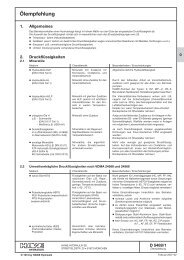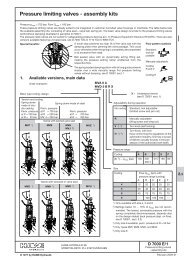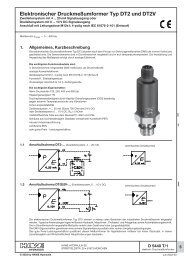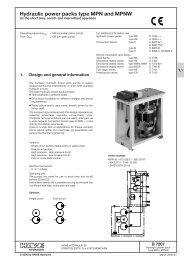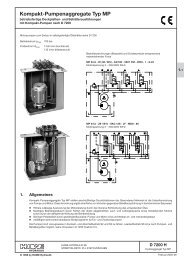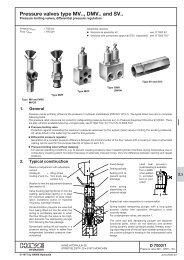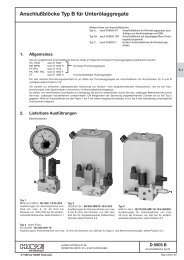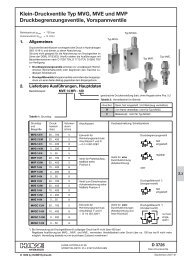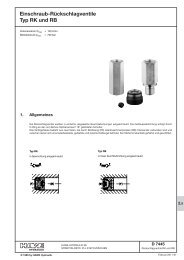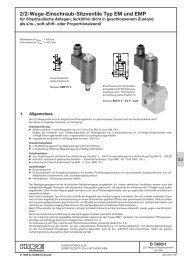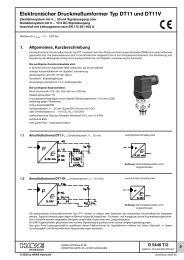Manual LAC Air Oil Coolers - Eurofluid
Manual LAC Air Oil Coolers - Eurofluid
Manual LAC Air Oil Coolers - Eurofluid
Create successful ePaper yourself
Turn your PDF publications into a flip-book with our unique Google optimized e-Paper software.
Catalogue HY10-6001-UM/EU<br />
Introduction/Safety instructions/Description<br />
Introduction<br />
The purpose of this manual is to serve as a reference guide for<br />
installation, maintenance and operation of the <strong>LAC</strong> series of air<br />
oil coolers.<br />
Keep the manual at hand. A lost manual should be replaced as<br />
soon as possible.<br />
For optimum performance and in order to prevent incorrect<br />
use, please read this manual carefully and observe all safety<br />
precautions prior to putting the air oil cooler into service.<br />
Installation and maintenance work should only be carried out by<br />
qualified personnel. Parker reserve the right to make technical<br />
alternations without notice.<br />
Use<br />
The <strong>LAC</strong>-series of air oil coolers is designed to cool hydraulic<br />
fluids in systems for industrial applications.<br />
Warranty and claims<br />
In the event of breakdown, consult your local Parker office. Parker<br />
shall not be held responsible for any consequences due to modification<br />
and/or variation made by the customer.<br />
Safety instructions<br />
The installation contractor as well as the user should be aware<br />
of, understand and observe all safety precautions in this manual,<br />
including any information mentioned on labels fixed to the product.<br />
Definition of Safety Warning Levels…<br />
…concerning personal safety<br />
All precautions concerning personal safety are classified as<br />
per below, depending on how severe the consequences of an<br />
incident could be.<br />
Danger aThis alerts you to an action or procedure that, if<br />
performed improperly, will produce bodily harm or death.<br />
Caution This alerts you to an action or procedure that, if<br />
performed improperly, is likely to produce bodily harm or<br />
death.<br />
Precaution This alerts you to an action or procedure that,<br />
if performed improperly, is likely to cause an accident with<br />
physical harm.<br />
…concerning other safety issues<br />
Notifications concerning other safety issues (property, process<br />
or environment) and maintenance work are classified as follows.<br />
Important This alerts you to an action or procedure that, if performed<br />
improperly, is likely to result in damages to the product,<br />
process or environment.<br />
...concerning additional information<br />
Additional information is marked as follows:<br />
Note! This alerts you to important information related to the text<br />
in a paragraph.<br />
Overall instructions<br />
Lifting<br />
Caution Risk of bodily injury. To prevent physical harm<br />
when lifting the unit, ensure correct lifting tech-nique.<br />
Make sure that all lifting devices are free from damage and<br />
approved for the weight of the air oil cooler.<br />
Installation<br />
Danger Electrical shock hazard. All electrical connections<br />
must be made by a qualified electrician!<br />
Installation and servicing manual<br />
<strong>Air</strong> <strong>Oil</strong> <strong>Coolers</strong>, <strong>LAC</strong><br />
Operation, handling and maintenance<br />
Caution Risk of bodily injury. Disconnect the motor power<br />
supply prior to maintenance.<br />
Caution Risk of bodily injury. Before disconnecting the<br />
hydraulic hoses and connections, make sure the system<br />
is depressurized.<br />
Caution Risk of severe burns. This indicates danger<br />
from high temperature surfaces. The air oil cooler could<br />
become extremely hot during operation. Always make<br />
sure the cooler is cool before touching.<br />
Precaution Risk of bodily injury. If the air oil cooler is<br />
fitted with a thermo contact, the fan will start automatically<br />
when the preset temperature has been reached. Be<br />
careful when standing close to rotating units.<br />
Precaution This indicates a toxic hazard. To prevent<br />
bodily injury, damage to property or environment, used<br />
fluid should be collected and taken to a special depôt.<br />
Important! Static electricity. Fans generate static electricity. Do not<br />
put sensitive devices (electronics etc.) in the immediate vicinity of<br />
the air oil cooler. Antistatic fans are available on request.<br />
Note! Use hearing protection when standing close to an operating<br />
air oil cooler for long periods of time.<br />
Warning label<br />
The warning label shown below is fitted to the air oil cooler at<br />
delivery. Always replace a damaged or missing label.<br />
Caution! High temperature surface! Use hearing protection!<br />
Rotating fan! (P/N 500029 - 70x30 mm or P/N 5000291 -<br />
120x50 mm) See Figure 1.<br />
Description<br />
Principally the <strong>LAC</strong> air oil cooler consists of a cooler matrix, an<br />
AC-motor, a fan, a fan housing and a fan guard. The cooler matrix<br />
is fitted to the hydraulic system with hydraulic hoses.<br />
Small air oil coolers are equipped with a single phase or three<br />
phase outer-rotor motor.<br />
Larger air oil coolers are equipped with a standard three phase<br />
asynchronous inner rotor motor according to IEC 60072 and<br />
IEC 60034.<br />
Normal ambient temperature for the electric motor:<br />
-20 °C - +40 °C. Connect the electrical motor to the electricity<br />
supply system according to Electrical connection.<br />
See, the rating plate for further information.<br />
The electric motor on large air oil coolers is equipped with a<br />
motor bracket. The air oil cooler can be provided with a thermo<br />
contact. The fan will then start automatically when the preset<br />
temperature has been reached.<br />
The acoustic pressure level could reach 50-92 LpA dB(A) at 1 m<br />
distance normal operating conditions. Inappropriate locatation,<br />
or operation under extreme conditions, could generate increase<br />
in acoustic pressure level and reduced cooling capacity. For<br />
general operating data, see Technical data.<br />
Identification plate<br />
The identification plate is fitted on the fan housing. See Figure 2.<br />
The identification plate contains the following information:<br />
A – Part number<br />
B – Designation<br />
C – Serial number<br />
D – Date of delivery<br />
(year and week, e.g. 1018, i.e. year 2010 and week 18).<br />
Replace a damaged or missing type plate as soon as possible.<br />
13 Parker Hannifin Corporation<br />
Hydraulics Group



